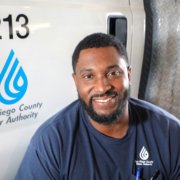The San Diego County Water Authority is the first public agency in California to participate in the Department of Defense SkillBridge Program, which connects transitioning military service members to career-track job training opportunities. The regional initiative is off to a fast start with two SkillBridge interns starting their civilian careers at the Water Authority this summer.
The Water Authority joined the federal program in June 2020, as part of an effort by the Water Authority and its 24 member agencies to meet the growing need for skilled water industry workers.
‘Silver tsunami’ of retirements in water industry
The opportunities for both transitioning servicemembers and local water agencies are significant. More than 30,000 service members separate from the military each year in California, and more than half are transitioning out of active duty in the San Diego region. Roughly half of the current water industry workforce in the San Diego region will be eligible to retire in the next 15 years – and approximately 1,400 water and wastewater industry jobs are expected to open in the region in the next five years.
SkillBridge Program interns served in Navy
The Water Authority’s Operations & Maintenance Department recently welcomed two SkillBridge interns, Gerald Moore and Jamaal Benjamin, who each bring more than 15 years of experience in the Navy.
“We have seen the skills and aptitudes they learned in the military directly transfer to their work at the Water Authority,” said Water Authority Board Chair Gary Croucher. “At a time when a wave of retirements is impacting the water industry, the SkillBridge Program is an important way to meet our need for skilled workers.”
The Water Authority is benefitting from Moore’s background in operating and maintaining computer systems.
“The Water Authority is all about teamwork and service, and they’ve welcomed me to their team with open arms,” said Moore. “This is a new phase of my career and life. I’m excited to find out where this journey will take me.”

“Having an opportunity to tap my military training and background in a civilian context is an ideal way to increase my career options in the water and wastewater industry,” said Jamaal Benjamin. Photo: San Diego County Water Authority
Benjamin is using his knowledge and experience working with complex electrical, electromechanical, and electrohydraulic systems to help maintain and repair critical water facilities.
“Having an opportunity to tap my military training and background in a civilian context is an ideal way to increase my career options in the water and wastewater industry,” said Benjamin.
Helping military veterans find jobs
A regional work group is implementing strategies to increase skilled workers for the water industry, with a focus on helping military veterans find jobs. Many of the Water Authority’s member agencies have also expressed interest in the SkillBridge Program.
“This is a unique opportunity to access a huge talent pool that can help us ensure the San Diego region will have the workforce to fill mission critical positions in the water industry,” said Christopher McKinney, chair of the regional work group and the director of utilities/assistant city manager for the City of Escondido.
Other regional efforts to help military veterans include state legislation co-sponsored by the Water Authority and Otay Water District that, when implemented, would provide a future avenue for veterans to receive credit for their military education and experience when applying for civilian water and wastewater system operator certifications in California.
Water industry job website
In addition, the San Diego County Water Authority maintains SanDiegoWaterWorks.org to provide a comprehensive and up-to-date list of regional water and wastewater industry job openings in one location, along with other information for veterans about career paths and internships.
SkillBridge Program
The Department of Defense created the SkillBridge Program in 2011 to give service members an opportunity to gain real-world training and work experience during their last 180 days of active service by interning at a civilian employer. The cost to partnering employers is minimal; employers pay no wages or benefits as service members continue to receive active duty pay and benefits during their internship.
For more information about regional job opportunities and training programs in the region’s water and wastewater industry go to: www.sandiegowaterworks.org/




